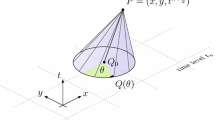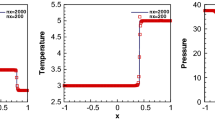Abstract
A Newton multigrid method is developed for one-dimensional (1D) and two-dimensional (2D) steady-state shallow water equations (SWEs) with topography and dry areas. The nonlinear system arising from the well-balanced finite volume discretization of the steady-state SWEs is solved by the Newton method as the outer iteration and a geometric multigrid method with the block symmetric Gauss-Seidel smoother as the inner iteration. The proposed Newton multigrid method makes use of the local residual to regularize the Jacobian matrix of the Newton iteration, and can handle the steady-state problem with wet/dry transition. Several numerical experiments are conducted to demonstrate the efficiency, robustness, and well-balanced property of the proposed method. The relation between the convergence behavior of the Newton multigrid method and the distribution of the eigenvalues of the iteration matrix is detailedly discussed.
Similar content being viewed by others
References
Vreugdenhil, C. B. Numerical Methods for Shallow-Water Flow, Springer, Dordrecht, 15–25 (1995)
Glaister, P. Approximate Riemann solutions of the shallow water equations. Journal of Hydraulic Research, 26, 293–306 (1988)
Li, J. Q. and Chen, G. X. The generalized Riemann problem method for the shallow water equations with bottom topography. International Journal for Numerical Methods in Engineering, 65, 834–862 (2006)
Noelle, S., Xing, Y., and Shu, C. W. High-order well-balanced finite volume WENO schemes for shallow water equation with moving water. Journal of Computational Physics, 226, 29–58 (2007)
Xing, Y. and Shu, C. W. High order finite difference WENO schemes with the exact conservation property for the shallow water equations. Journal of Computational Physics, 208, 206–227 (2005)
Tang, H. Z., Tang, T., and Xu, K. A gas-kinetic scheme for shallow-water equations with source terms. Zeitschrift für Angewandte Mathematik und Physik, 55, 365–382 (2004)
Xu, K. A well-balanced gas-kinetic scheme for the shallow-water equations with source terms. Journal of Computational Physics, 178, 533–562 (2002)
Tang, H. Z. Solution of the shallow-water equations using an adaptive moving mesh method. International Journal for Numerical Methods in Fluids, 44, 789–810 (2004)
Kesserwani, G. and Liang, Q. A conservative high-order discontinuous Galerkin method for the shallow water equations with arbitrary topography. International Journal for Numerical Methods in Engineering, 86, 47–69 (2011)
Xing, Y., Zhang, X., and Shu, C. W. Positivity-preserving high order well-balanced discontinuous Galerkin methods for the shallow water equations. Advances in Water Resources, 33, 1476–1493 (2010)
Bilanceri, M., Beux, F., Elmahi, I., Guillard, H., and Salvetti, M. V. Linearized implicit time-advancing and defect correction applied to sediment transport simulations. Computers & Fluids, 63, 82–104 (2012)
Hudson, J. Numerical techniques for morphodynamic modelling. University of Reading, 23, 382–384 (2001)
Spitaleri, R. M. and Corinaldesi, L. A multigrid semi-implicit finite difference method for the two dimensional shallow water equations. International Journal for Numerical Methods in Fluids, 25, 1229–1240 (1997)
Sármány, D., Hubbard, M. E., and Ricchiuto, M. Unconditionally stable space-time discontinuous residual distribution for shallow-water flows. Journal of Computational Physics, 253, 86–113 (2013)
Bagheri, J. and Das, S. K. Modelling of shallow-water equations by using implicit higher-order compact scheme with application to dam-break problem. Journal of Applied and Computational Mathematics, 2, 1000132 (2013)
Dumbser, M. and Casulli, V. A staggered semi-implicit spectral discontinuous Galerkin scheme for the shallow water equations. Applied Mathematics and Computation, 219, 8057–8077 (2013)
Tavellia, M. and Dumbserb, M. A high order semi-implicit discontinuous Galerkin method for the two dimensional shallow water equations on staggered unstructured meshes. Applied Mathematics and Computation, 234, 623–644 (2014)
Glaister, P. On the efficient solution of the steady, two dimensional shallow water equations. International Journal of Computer Mathematics, 54, 97–108 (1994)
Chen, R. F. and Wang, Z. J. Fast, block lower-upper symmetric Gauss-Seidel scheme for arbitrary grid. AIAA Journal, 38, 2238–2245 (2000)
Hu, G., Li, R., and Tang, T. A robust high-order residual distribution type scheme for steady Euler equations on unstructured grids. Journal of Computational Physics, 229, 1681–1697 (2010)
Jameson, A. Analysis and design of numerical schemes for gas dynamics 1: artificial diffusion, upwind biasing, limiters and their effect on accuracy and multigrid convergence. International Journal of Computational Fluid Dynamics, 4, 171–218 (1995)
Li, R., Wang, X., and Zhao, W. B. A multigrid BLU-SGS algorithm for Euler equations on unstructured grids. Numerical Mathematics: Theory, Methods and Applications, 1, 92–112 (2008)
Mavriplis, D. J., Jameson, A., and Martinelli, L. Multigrid solution of the Navier-Stokes equations on triangular meshes. AIAA Journal, 28, 1415–1425 (1990)
Audusse, E., Bouchut, F., Bristeau, M., Klein, R., and Perthame, B. A fast and stable well-balanced scheme with hydrostatic reconstruction for shallow water flows. SIAM Journal on Scientific Computing, 25, 2050–2065 (2004)
Liang, Q. and Borthwick, A. G. L. Adaptive quadtree simulation of shallow flows with wet-dry fronts over complex topography. Computers and Fluids, 38, 221–234 (2009)
Toro, E. F., Spruce, M., and Speares, W. Restoration of the contact surface in the HLL Riemann solver. Shock Waves, 4, 25–34 (1994)
LeVeque, R. J. Finite Volume Methods for Hyperbolic Problems, Cambridge University Press, Cambridge, 525–531 (2002)
Toro, E. F. Shock-capturing Methods for Free-Surface Shallow Flows, John Wiley & Sons, New York, 110–114 (2001)
Vazquez-Cendon, M. E. Improved treatment of source terms in upwind schemes for the shallow water equations in channels with irregular geometry. Journal of Computational Physics, 148, 497–526 (1999)
Delestre, O., Lucas, C., Ksinant, P. A., Darboux, F., Laguerre, C., Vo, T. N. T., James, F., and Cordier, S. SWASHES: a compilation of shallow water analytic solutions for hydraulic and environmental studies. International Journal for Numerical Methods in Fluids, 72, 269–300 (2013)
Zienkiewicz, O. C. and Ortiz, P. A split-characteristic based finite element model for the shallow water equations. International Journal for Numerical Methods in Fluids, 20, 1061–1080 (1995)
Hubbard, M. E. On the accuracy of one-dimensional models of steady converging/diverging open channel flows. International Journal for Numerical Methods in Fluids, 35, 785–808 (2001)
Author information
Authors and Affiliations
Corresponding author
Additional information
Project supported by the National Natural Science Foundation of China (Nos. 91330205 and 11421101) and the National Key Research and Development Program of China (No. 2016YFB0200603)
Rights and permissions
About this article
Cite this article
Wu, K., Tang, H. A Newton multigrid method for steady-state shallow water equations with topography and dry areas. Appl. Math. Mech.-Engl. Ed. 37, 1441–1466 (2016). https://doi.org/10.1007/s10483-016-2108-6
Received:
Revised:
Published:
Issue Date:
DOI: https://doi.org/10.1007/s10483-016-2108-6




